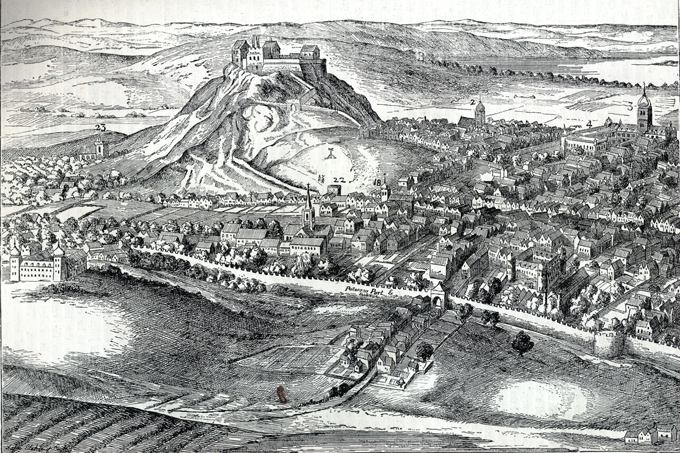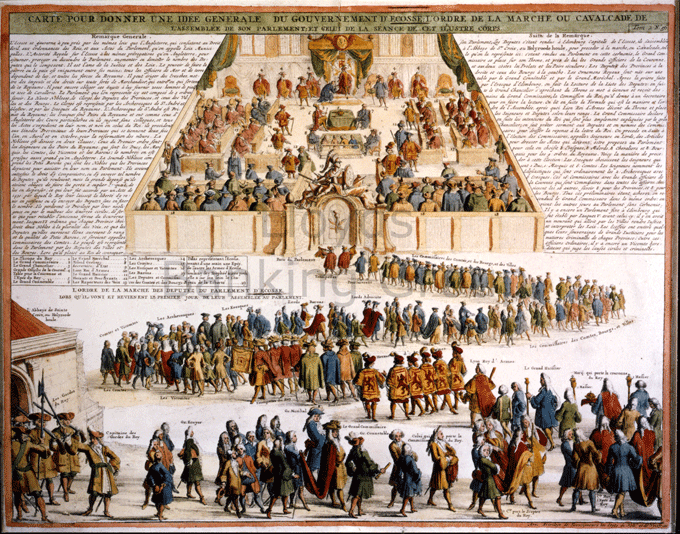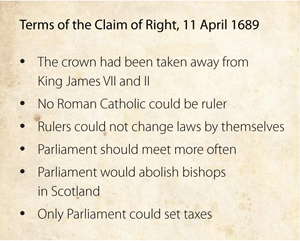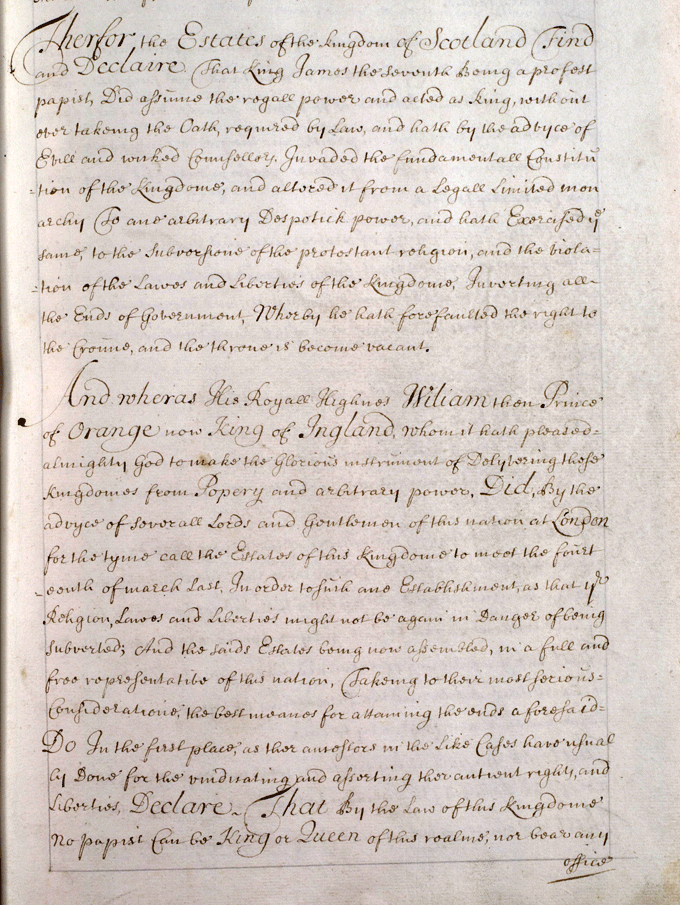| | Home | Resources | Schools Programme | Teachers | Site help | About us | Contact us | |
| You are here: Home > Resources > The Union of 1707 > The Scottish Parliament before the Union |
The Scottish Parliament before the UnionParliamentary union between Scotland and England had been suggested on several occasions since the Union
of the Crowns in 1603, when James VI of Scotland became King James I of England. Matters
became more urgent in 1700 following the death of the last surviving child of the future Queen, Anne. Both Parliaments in Edinburgh and London began to quarrel over who should succeed
her. Relations between the Parliaments got worse. A peaceful solution had to be found. |
||||
The Scottish ParliamentBy the late 16th century, the Scottish Parliament had settled in Edinburgh. Parliament House was built in the 1630s as the central meeting place for the Parliament. Members of the Parliament included bishops, chosen by the King; members of the nobility with titles like duke and earl; landowners or lairds, and town burgesses who represented the main Scottish burghs. The members of Parliament were known as ‘commissioners’. Burgh commissioners were elected by their town councils, and shire commissioners by the lairds of the county. They all sat together in the same chamber. 
An engraving of old Edinburgh from Cassell's Old and New Edinburgh, vol.1, p.125. |
||||
The Downsitting of Parliament, 1685The annual opening was a very grand affair with a procession known as the riding of Parliament that went from Holyrood Palace up the Royal Mile to Parliament House. The riding was led by the Chancellor and his officials who were responsible for keeping order in Parliament. A description of the riding of Parliament in 1669 records trumpeters at the head of the procession, dressed in red uniforms with silver lace, followed by the commissioners for the burghs, then those for the shires, then the bishops and the nobility. They in turn were followed by the Lord Lyon King of Arms, who was accompanied by trumpeters and heralds who carried the honours of Scotland - the crown, sword and sceptre – that symbolised the monarch. The King was represented by his High Commissioner, richly dressed in a velvet coat and justicoat [a sleeveless waistcoat] of embroidered cloth of gold. 

The Downsitting of the Scottish Parliament c.1685. Reproduced courtesy of Lloyds Banking Group plc Archives. Photograph by Antonia Reeve. |
||||
| ||||
Parliament and the Glorious Revolution of 1689James VII succeeded to the throne in 1685. He was a Roman Catholic and wanted to force through toleration of his religion in the country. His Parliaments in Scotland and in England would not do this so he changed the laws himself and gave Catholics important jobs in his government. He soon became unpopular as king. In 1688 when his second wife gave birth to a son, who under the law of succession would become the next king and would be a Catholic, many of the nobles acted. They wrote secretly to James’s protestant daughter Mary and her husband, William of Orange, in the Netherlands and invited them to rule instead. James fled to France. His behaviour and his religion had caused his overthrow. In 1689, the Scottish Parliament decided that James was no longer king and had forfeited the crown by failing to maintain the protestant religion and to rule the country according to law. Parliament laid down terms that William and Mary had to accept before they were allowed to rule. | ||||
The Claim of Right, 1689
The Claim of Right was the foundation of the Revolution settlement in Scotland. It opposed James being a Catholic and called for more regular meetings of Parliament to be held. The terms in the Claim of Right set out to limit the powers of the crown, to strengthen those of Parliament, and to restore the presbyterian system in Scotland where members of each church, and not bishops, could elect their own minister. This extract from the Claim of Right is taken from the official Acts of the Scottish Parliament for the year 1689. Therfor the Estates of the Kingdom of Scotland Find and Declaire that King James the seventh, being a profest papist, Did assume the royall power, and acted as king without ever taking the Oath required by Law, and hath by the advyce of Evill and wicked Counsellors, Invaded the fundamental Constitution of the Kingdome, and altered it from a Legall Limited monarchy, To ane arbitrary Despotick power, and hath Exercised the same to the subversione of the protestant religion, and the violation of the Lawes and Liberties of the Kingdome, Inverting all the Ends of Government, Wherby he hath forefaulted the right to the Crowne, and the throne is become vacant. And wheras His Royall Highnes Wiliam then Prince of Orange now King of Ingland whom it hath pleased almighty God to make the Glorious instrument of Delyvering these Kingdomes from Popery and arbitrary power, Did, By the advyce of severall Lords and Gentlemen of this nation, at London for the tyme call the Estates of this Kingdome to meet the fourteenth of march Last, In order to fu[rni]sh ane Establishment as that th[ei]r Religion, Lawes and Liberties might not be again in Danger of being subverted; And the saids Estates being now assembled, in a full and free representative of this nation, Takeing to their most serious consideratione, the best meanes for attaining the ends aforesaid Do… Declare That By the law of this Kingdome no papist can be King or Queen of this realme, nor bear any office whatsomever therin; nor can any protestant successor exercise the royall power until he or she swear the Coronation Oath. 
(National Records of Scotland, Acts of Parliament, PA2/33 p.38) | ||||
The Abolition of the Lords of the ArticlesThe other major part of the Revolution settlement in Scotland was the abolition of the Lords of the Articles. This committee had been used by the monarch since the reign of King James VI and I as a means of controlling Parliament, to ensure that only legislation the crown approved of came before the house or ‘estates’. Its abolition, on 8 May 1690, meant that for the first time the Scottish Parliament was able to operate as an independent body. With Parliament free to discuss whatever it wanted, this in time made it harder for William to control Scotland. …the Committee of Parliament called the Articles is a great grievance to the Natione, And that there ought to be noe Committees of Parliament but such as are freely chosen by the Estates to prepare motions and overtures that are first made in the house… (National Records of Scotland, Acts of Parliament, PA2/34, fol.8) | ||||
|
|